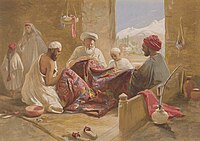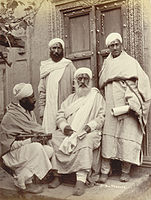
Kashmir (/ˈkæʃˌmɪər/; Kashmiri: کٔشیٖر, romanized: Kạšīr, Kashmiri pronunciation: [kəˈʃiːr]) is the northernmost geographical region of the Indian subcontinent. Until the mid-19th century, the term "Kashmir" denoted only the Kashmir Valley between the Great Himalayas and the Pir Panjal Range. Today, the term encompasses a larger area that includes the India-administered territories of Jammu and Kashmir and Ladakh, the Pakistan-administered territories of Azad Kashmir and Gilgit-Baltistan, and the Chinese-administered territories of Aksai Chin and the Trans-Karakoram Tract.[1][2][3]
In 1820, the Sikh Empire, under Ranjit Singh, annexed Kashmir.[4] In 1846, after the Sikh defeat in the First Anglo-Sikh War, and upon the purchase of the region from the British under the Treaty of Amritsar, the Raja of Jammu, Gulab Singh, became the new ruler of Kashmir. The rule of his descendants, under the paramountcy (or tutelage[5][6]) of the British Crown, lasted until the Partition of India in 1947, when the former princely state of the British Indian Empire became a disputed territory, now administered by three countries: China, India, and Pakistan.[1][7][8][2]
In the 1901 Census of the British Indian Empire, the population of the princely state of Kashmir and Jammu was 2,905,578. Of these, 2,154,695 (74.16%) were Muslims, 689,073 (23.72%) Hindus, 25,828 (0.89%) Sikhs, and 35,047 (1.21%) Buddhists (implying 935 (0.032%) others).
The Hindus were found mainly in Jammu, where they constituted a little less than 60% of the population.[66] In the Kashmir Valley, the Hindus represented "524 in every 10,000 of the population (i.e. 5.24%), and in the frontier wazarats of Ladhakh and Gilgit only 94 out of every 10,000 persons (0.94%)."[66] In the same Census of 1901, in the Kashmir Valley, the total population was recorded to be 1,157,394, of which the Muslim population was 1,083,766, or 93.6% and the Hindu population 60,641.[66] Among the Hindus of Jammu province, who numbered 626,177 (or 90.87% of the Hindu population of the princely state), the most important castes recorded in the census were "Brahmans (186,000), the Rajputs (167,000), the Khattris (48,000) and the Thakkars (93,000)."[66]
In the 1911 Census of the British Indian Empire, the total population of Kashmir and Jammu had increased to 3,158,126. Of these, 2,398,320 (75.94%) were Muslims, 696,830 (22.06%) Hindus, 31,658 (1%) Sikhs, and 36,512 (1.16%) Buddhists. In the last census of British India in 1941, the total population of Kashmir and Jammu (which as a result of the Second World War, was estimated from the 1931 census) was 3,945,000. Of these, the total Muslim population was 2,997,000 (75.97%), the Hindu population was 808,000 (20.48%), and the Sikh 55,000 (1.39%).[67]
The Kashmiri Pandits, the only Hindus of the Kashmir valley, who had stably constituted approximately 4 to 5% of the population of the valley during Dogra rule (1846–1947), and 20% of whom had left the Kashmir valley to other parts of India in the 1950s,[68] underwent a complete exodus in the 1990s due to the Kashmir insurgency. According to a number of authors, approximately 100,000 of the total Kashmiri Pandit population of 140,000 left the valley during that decade.[69][70][71] Other authors have suggested a higher figure for the exodus, ranging from the entire population of over 150 thousand,[72] to 190 thousand of a total Pandit population of 200 thousand (200,000),[73] to a number as high as 300 thousand (300,000).[74]
People in Jammu speak Hindi, Punjabi and Dogri, the Kashmir Valley people speak Kashmiri, and people in the sparsely inhabited Ladakh speak Tibetan and Balti.[1]
The population of India-administered union territories of Jammu and Kashmir and Ladakh combined is 12,541,302;[75] that of Pakistan-administered territory of Azad Kashmir is 4,045,366; and that of Gilgit-Baltistan is 1,492,924.[76][77]


